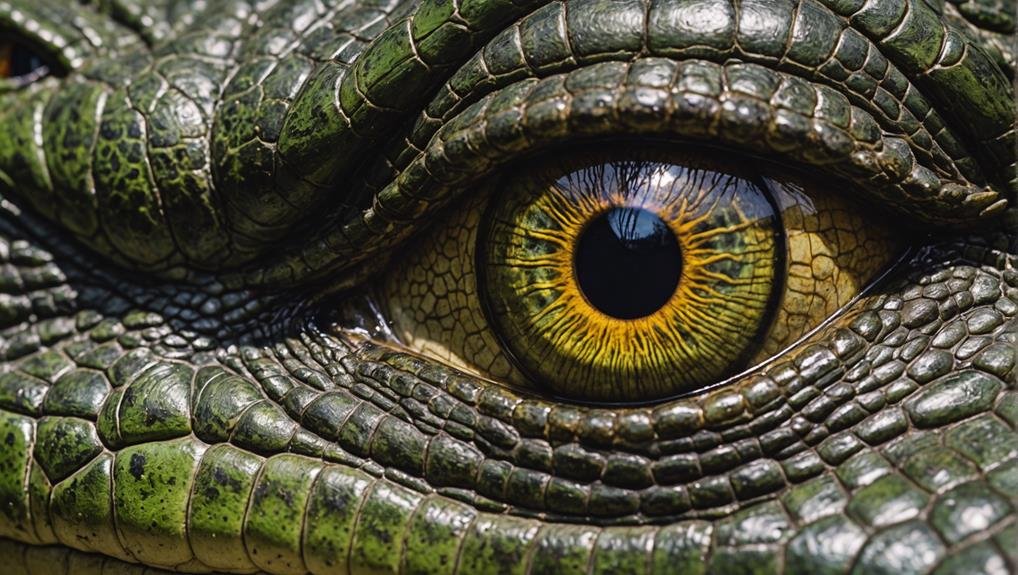When you think about eyesight, you might take for granted the unique capabilities of human vision, but have you ever considered how it stacks up against a crocodile’s? Crocodiles have evolved remarkable features in their eyes, like a foveal and horizontal streak, offering them a significant edge in hunting. Their ability to retract their eyeballs and scan their surroundings with a 270-degree field of vision is fascinating. Unlike humans, who have a 180-degree view, crocodiles can keep an eye on their Prey with minimal head movement. Curious about how these differences impact their survival strategies?
Key Takeaways
- Crocodile eyes have a 270-degree field of vision, compared to the human 180-degree field.
- Unlike the human central fovea, crocodiles feature a specialized horizontal foveal streak for sharp horizon scanning.
- Crocodile retinas are adapted for low-light conditions with the tapetum lucidum, enhancing night vision.
- Unlike humans, crocodiles have retractable eyeballs and a separate lens cover for underwater vision.
- Crocodile eyesight is 6-7 times less precise than human vision but excels in detecting movement.
Anatomy of Crocodile Eyes
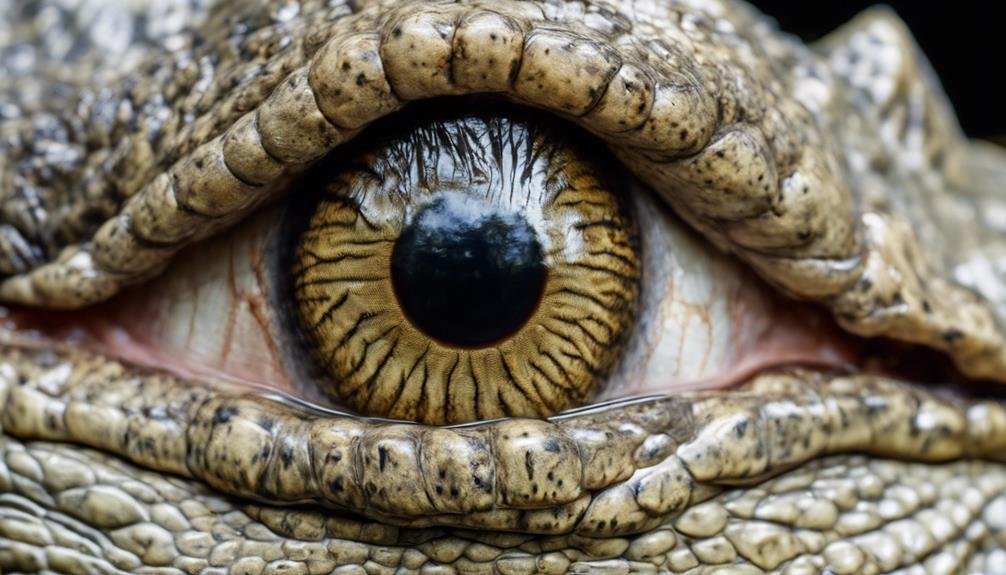

Crocodile eyes are marvels of evolutionary adaptation, designed to offer superior vision in various environments. These unique eyes feature a specialized retina that provides excellent day and night vision. This capability makes crocodiles highly effective hunters. Placing their eyes on stalks allows them to stealthily approach Prey without revealing their position, giving them a significant hunting advantage.
Crocodiles possess a wide-angle vision of about 270 degrees, which minimizes the need for head movement while scanning their surroundings. This broad field of view helps them stay alert to potential threats or Prey. Additionally, crocodile eyes have retractable eyeballs, a feature that protects them during fights or when submerged underwater.
Crocodile eyes utilize a separate lens cover that acts like goggles when underwater. This adaptation enhances their vision in aquatic environments, ensuring they can see beneath the water’s surface. Combining these features makes crocodile eyes extraordinarily versatile and efficient, allowing these ancient reptiles to thrive in diverse habitats. The intricate anatomy of crocodile eyes demonstrates nature’s remarkable ability to evolve highly specialized organs for survival.
Foveal Streak Functionality
You might find it fascinating how crocodiles use their foveal streak for enhanced visual clarity, allowing them to detect Prey efficiently. This streak lets them scan the shoreline without moving, ensuring they remain undetected.
Unlike other animals, crocodiles’ specialized visual system provides high-resolution vision for survival.
Enhanced Visual Clarity
Imagine looking out over a horizon with perfect clarity, every detail sharp and distinct. That’s the advantage crocodiles have with their foveal streak. This specialized feature grants them unparalleled visual sharpness, making them exceptional hunters. Unlike humans with a small central fovea, crocodiles have a foveal streak that stretches horizontally. This allows them to scan the shoreline effortlessly without moving their heads.
Their foveal streak plays a significant role in maintaining visual sharpness. This unique adaptation is essential for hunting, enabling them to detect even the slightest movements of potential Prey. The high-resolution vision provided by the foveal streak means a crocodile can lurk with minimal movement, conserving energy while staying alert.
| Feature | Crocodile Eyes | Human Eyes |
|---|---|---|
| Foveal Streak | Horizontal, long | Small, central |
| Visual Sharpness | High across horizon | High in the center |
| Hunting Efficiency | Enhanced by sharpness | I have not specialized in this |
Thanks to this remarkable adaptation, crocodiles dominate their environments. The foveal streak’s unique wiring allows them to maintain maximum visual sharpness, making them apex predators. The next time you look out over a horizon, consider the crocodile’s edge in visual acuity—it’s a tribute to nature’s ingenuity.
Prey Detection Efficiency
Crocodiles excel as stealthy hunters because their foveal streak enhances prey detection. You might wonder how they manage to stay still yet remain so effective. The secret lies in their foveal streak, which spans the back of their eyes. This unique feature allows them to detect Prey precisely without moving their heads.
Imagine focusing on potential Prey in fine detail while maintaining a steady visual horizon. Crocodiles can do this, thanks to their foveal streak adaptation. This capability greatly boosts their hunting efficiency, as they can scan their surroundings meticulously while minimizing any head movement that might alert their Prey.
The foveal streak serves several key functions:
- Enhanced detail focus: Crocodiles can pick out details of potential Prey from a distance.
- Steady horizon maintenance: The foveal streak helps stabilize their visual field, which is essential for lurking and waiting.
- Reduced head movement: They can scan for Prey efficiently without losing their position.
Light Adaptations in Crocodiles
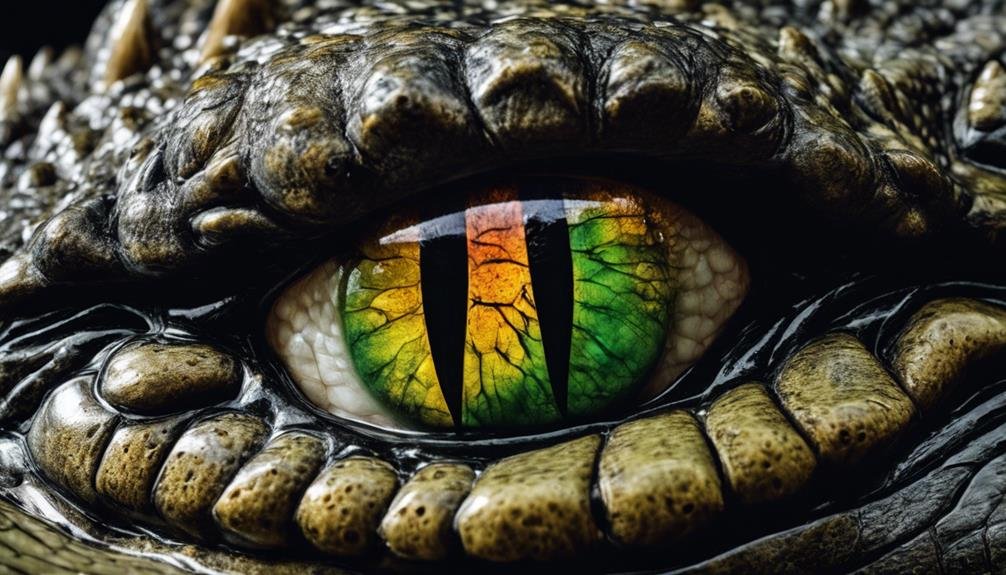

Crocodiles have evolved remarkable light adaptations in their eyes, enabling them to thrive in their semi-aquatic environments. One significant adaptation is the horizontal streak in their fovea, which enhances their ability to see clearly along the visual horizon. This feature is pivotal when they lurk with their eyes above the water, waiting motionless for Prey. Their underwater vision is less precise than that of humans, but it’s perfectly suited to their needs.
Additionally, crocodiles have a unique wiring arrangement in their eyes, different from other animals’ visual streaks. This adaptation allows them to detect movements and changes in light more efficiently, especially in dim or red light conditions often found in their habitats. Although their eyesight is six to seven times less precise than human vision, these adaptations make them formidable predators in aquatic and terrestrial environments.
Here’s a quick comparison to make it clearer:
| Feature | Crocodile Eyes | Human Eyes |
|---|---|---|
| Foveal Streak | Horizontal | Centralized |
| Vision Underwater | Adapted but less precise | Not adapted |
| Red Light Detection | Efficient | Less efficient |
| Precision | 6-7 times less accurate | Highly precise |
| Primary Adaptation | Lurking, motion detection | Detailed imagery |
Understanding these light adaptations highlights how crocodiles are finely tuned to their environments.
Hunting Efficiency
Building on the remarkable light adaptations in crocodile eyes, their hunting efficiency is equally impressive. Crocodile eyes are specialized to detect shapes and shades in any condition, giving them an edge over their Prey. Their eyes can self-adjust for both short-sighted and long-sighted vision, allowing these predators to spot Prey from far distances or up close without any trouble.
One of the most fascinating features is the foveal streak, which provides a wide field of vision. Crocodiles can scan the shoreline without moving their heads, making them stealthy hunters.
Additionally, crocodile eyes can detect even the slightest movement thanks to their horizontal streak of receptors, enhancing their ability to capture Prey efficiently.
- Broad Field of Vision: The foveal streak enables a broad scanning area without head movement.
- Vision Adjustment: Self-adjusting eyes for both near and far sight.
- Movement Detection: A horizontal streak of receptors detects the smallest movements.
With these sophisticated adaptations, crocodiles have evolved to become one of the most efficient hunters in the animal kingdom. Their eyes contribute significantly to their success, making them formidable predators in any environment.
Color Vision Capabilities
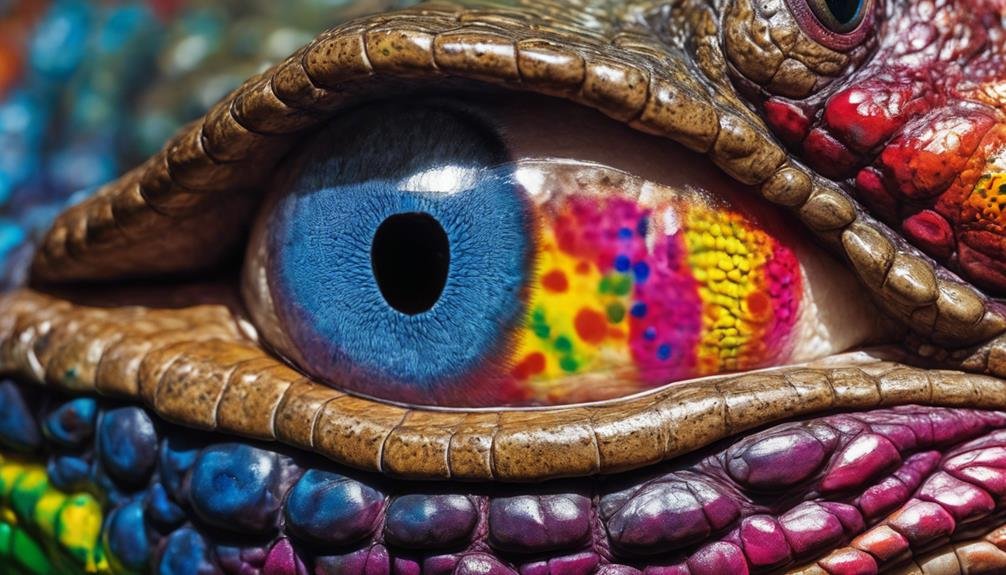

You’ll find some fascinating differences when comparing crocodile color perception to human color vision. Crocodiles possess sophisticated color vision, with photoreceptors finely tuned to various light conditions, particularly underwater.
In contrast, human eyes are adapted for a broad range of light environments but don’t match the specialized capabilities of crocodile eyes in aquatic settings.
Crocodile Color Perception
Crocodiles’ color vision is surprisingly sophisticated and finely tuned for their aquatic environments. Their vision, particularly their color perception, is a marvel of adaptation. With photoreceptors sensitive to different wavelengths, these reptiles can discern various colors that aid their survival.
In saltwater species, photoreceptors are shifted to shorter wavelengths, optimizing their vision for underwater light conditions. Freshwater crocodiles also exhibit specialized adaptations, ensuring they can navigate and hunt effectively in their unique habitats. This refined color perception isn’t just for show; it plays a pivotal role in their hunting strategies, allowing them to detect Prey with remarkable precision.
Key points about crocodile color perception:
- Adaptation to Habitat: Both saltwater and freshwater crocodiles have evolved their color vision to suit their specific environments.
- Photoreceptor Sensitivity: Crocodiles possess photoreceptors that are finely tuned to different wavelengths, enhancing their ability to perceive colors.
- Survival Mechanism: Superior color vision is vital for hunting and overall survival, giving crocodiles an edge in their natural habitats.
Human Color Vision
While crocodile color sight is impressively adjusted to their aquatic surroundings, human color vision is equally fascinating but customized for different requirements. You possess trichromatic color vision thanks to three types of cones in your eyes. Each cone is sensitive to varying wavelengths of light: red, green, and blue. Combining these cones lets you perceive millions of devices, enhancing your daily experiences.
Color vision is essential for many of your everyday tasks. For instance, identifying ripe fruits, reading traffic lights, and enjoying art all rely on your ability to distinguish between various colors. Your color perception also plays a significant role in choosing clothing and appreciating the beauty of nature.
However, not everyone experiences color vision the same way. Approximately 8% of men and 0.5% of women are affected by color blindness, resulting in deficiencies in specific cones. This means some people may struggle to distinguish between certain colors, impacting their ability to perform tasks that require accurate color identification.
In essence, your color vision capabilities are crucial to how you interact with the world, making everyday activities both practical and enjoyable.
Night Vision Strengths
CrocWorlds have exceptional night vision thanks to the reflective gems in their eyes. These reflective gems, also known as tapetum lucidum, play a pivotal role in enhancing their night vision. They work by intensifying the available light, greatly enhancing a crocodile’s ability to see in low-light conditions. This gives them a distinct advantage when hunting after the sun goes down.
When you think about their night vision, it’s intriguing to realize how their eyes adapt to the dark. Crocodiles effectively switch to a night-vision mode, enabling them to detect even the slightest movements in the water or on land. This makes them formidable nocturnal predators.
Here are some key points about crocodile night vision:
- Reflective gems amplify the light that enters their eyes, aiding in low light detection.
- Night vision mode: Crocodiles can shift their vision to continue hunting during nighttime hours.
- Movement detection: Their specialized eyes are highly sensitive to movement, even in near-complete darkness.
Comparing Sharpness
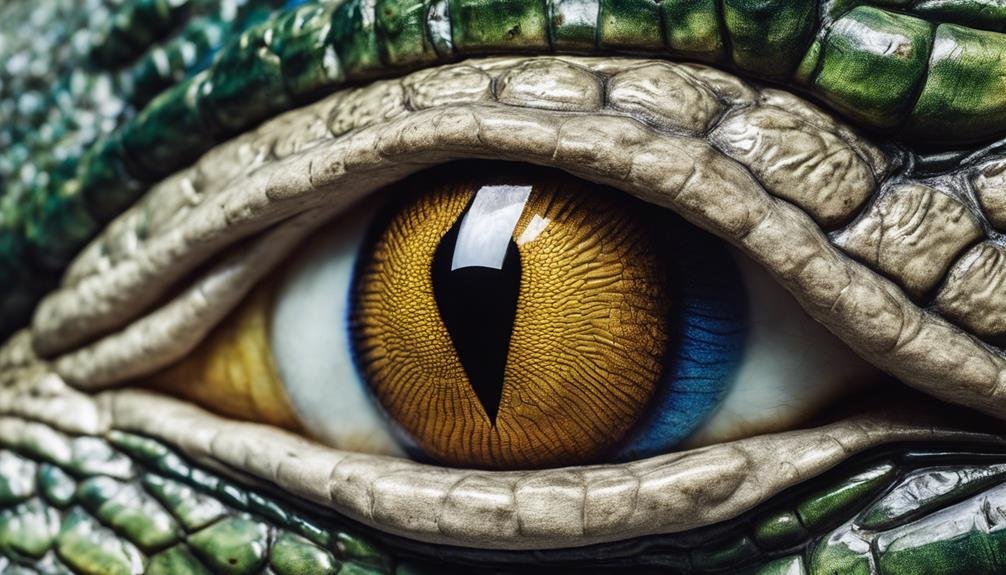

When comparing sharpness, you’ll find that crocodile eyes have a horizontal foveal streak, allowing them to scan the horizon effectively. This adaptation, coupled with their multi-focal lenses, helps them spot Prey with minimal head movement.
On the other hand, human eyes focus sharply in the center, which is ideal for detailed tasks but less suited for broad, horizontal scanning.
Horizontal Foveal Streak
Imagine peering just above the water’s surface, your vision honed to detect the slightest movement along the horizon. Crocodiles have this advantage thanks to their horizontal foveal streak. This unique adaptation gives them sharp vision across the visual horizon, making them formidable hunters. Crocodiles can stay motionless with just their eyes above the water, waiting for the perfect moment to strike.
Unlike human eyes, which lack this specialized feature, crocodile eyes have a foveal streak that maximizes clarity in their aquatic environment. Here’s how it benefits them:
- Enhanced Peripheral Detection: The horizontal foveal streak allows crocodiles to scan a wide area along the water’s surface without moving their heads.
- Stealth Hunting: Crocodiles can stay submerged and undetected while monitoring their surroundings by providing sharp vision just above the water.
- Efficient Prey CapturWith their clear and shavisionistheyhem accurately time their attacks on unsuspecting Prey.
Despite crocodile vision being six to seven times less precise than human vision, their foveal streak is perfect for their hunting needs. This specialized wiring in their eyes offers an edge in their natural habitat, where sharpness along the horizon can mean the difference between a meal and an empty stomach.
Multi-Focal Lens Adaptation
While the horizontal foveal streak equips crocodiles with excellent peripheral detection, their multi-focal lens adaptation takes their vision to another level. Crocodile eyes are designed with high-performance multi-focal lenses catering to short-ted vision. This unique adaptation allows crocodiles to maintain sharp vision, whether they’re focusing on distant objects or tiny movements up close.
Imagine you’re a crocodile lying in wait for Prey. Thanks to your multi-focal lens adaptation, you don’t need to move to hone in on potential targets. Your eyes can self-adjust to see shapes and shades clearly in any condition, enhancing your hunting capabilities immensely.
Whether it’s a bird flying far away or a fish swimming right in front of you, your vision remains sharp and precise.
This remarkable sharp vision provides crocodiles with a significant advantage. They can detect Prey from far distances and react instantly to small, rapid movements nearby. The ability to see clearly across various distances without losing clarity makes crocodile eyes a formidable tool in the wild.
In contrast, human eyes typically require corrective lenses to achieve similar sharpness over multiple focal lengths.
Field of Vision Differences
Understanding the field of vision differences between crocodile eyes and human eyesight reveals fascinating adaptations in both species. Crocodile eyes have a significant advantage with a field of vision of about 270 degrees. This wide-angle vision allows them to spot Prey or threats from various angles without turning their heads.
In contrast, human eyes have a field of vision around 180 degrees, demonstrating a narrower range.
Crocodiles’ expansive field of vision is pivotal for their survival. They can see above and below the water simultaneously, which is particularly beneficial when hunting or avoiding danger. This capability means they rely less on head movement to scan their environment, providing a stealthy edge in their aquatic habitats.
On the other hand, human eyes have a more limited field of vision. This narrower range impacts one’s ability to perceive threats or opportunities from different directions, requiring one to turn one’s head more frequently to get a complete view of one’s surroundings.
Here are some key points for comparison:
- Crocodile eyes: 270-degree field of vision.
- Human eyes: 180-degree field of vision.
- Crocodile advantage: Can see above and below water simultaneously.
Eye Movement Mechanics
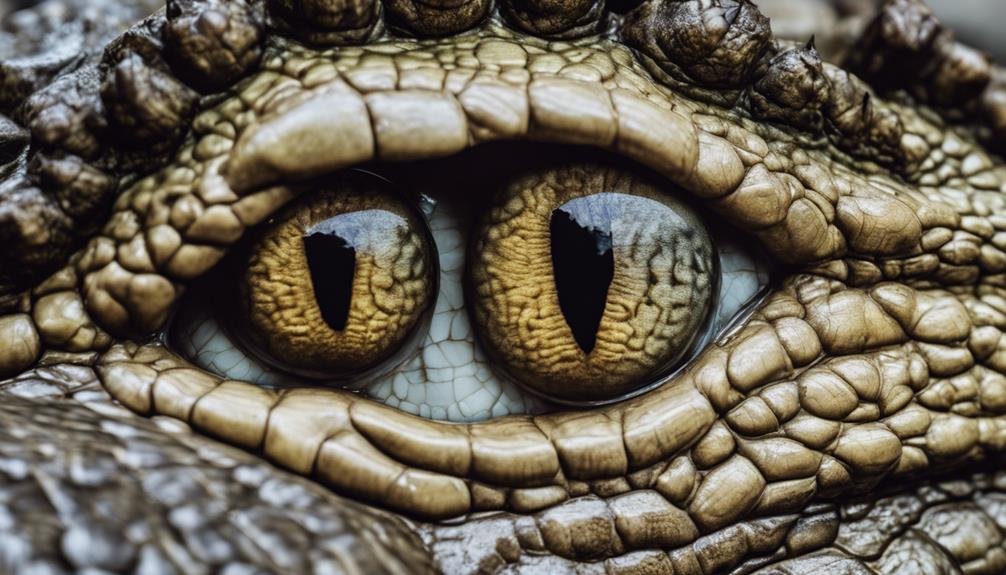

How do crocodiles achieve such a wide field of vision? It’s all about their eye movement mechanics. Crocodiles have the remarkable ability to move their eyes independently. This means each eye can look in different directions simultaneously, giving them an expansive field of vision. You might think of chameleons when you hear about independent eye movement, but crocodiles share this trait, too.
The fovea in their eyes forms a unique horizontal streak, which is significant for sharp vision along the visual horizon. This foveal streak adaptation maintains maximum clarity across a broad sight range, ensuring they don’t miss any potential prey or threats.
Unlike humans, who depend on coordinated eye movement for depth perception, crocodiles’ independent eye movement allows them to survey their surroundings more efficiently.
Other animals like grackles and dragonflies also exhibit similar eye movement capabilities, but crocodiles are particularly adept at using this feature to enhance their field of vision. So, while you might need to turn your head to see what’s around you, crocodiles shift their eyes independently, staying alert and aware of everything in their environment.
Evolutionary Adaptations
We’ve explored how crocodiles’ eye movement mechanics provide them with a wide field of vision, but there’s more to their visual prowess. Over 200 million years, crocodile eyes have evolved to become highly specialized for hunting. This remarkable adaptation, studied extensively by researchers at the University of Western, reveals the incredible capabilities of the crocodile retina.
The unique fovea in crocodile eyes is a prime example of this evolution. It allows for excellent vision day and night, ensuring these predators can hunt effectively under varying light conditions. Additionally, their eyes possess a wide-angle vision of about 270°, notably reducing the need for head movements and allowing crocodiles to remain stealthy while stalking Prey.
Here are some fascinating evolutionary adaptations of crocodile eyes:
- Retractable eyeballs: Protect their eyes during fights or when capturing Prey.
- Underwater vision: Their eyes change structure to function like built-in goggles, enhancing underwater sight.
- Durability: The crocodile retina has adapted to withstand various environmental challenges, ensuring long-term visual efficiency.
These adaptations underscore the evolutionary marvel that’s the crocodile’s eyesight, providing them with a noteworthy advantage in their aquatic and terrestrial habitats.
Conclusion
You’ll see fascinating differences in adaptation and functionality when comparing crocodile eyes and human eyesight. Crocodiles have evolved specialized retinas, wide-angle vision, and unique hunting adaptations that give them an edge in their environment. Meanwhile, human eyes are versatile across various light conditions, although they lack some hunting advantages. Understanding these differences highlights the incredible evolutionary paths that shape how each species interacts with the world around them.
FAQs
1. What Is the Difference Between the Human Eye and the Crocodile Eye?
Your world-class crocodile eyes have slit-shaped pupils, excellent night vision, and limited color perception. Human eyes, with round pupils, have better color perception but poorer night vision, making these key differences quite fascinating.
2. What Is Special About Crocodile Eyes?
What’s special about crocodile eyes? They have impressive night vision abilities, unique vertical slit-shaped pupils for precise light control, and specialized underwater hunting techniques, including a lens cover like built-in goggles.
3. Which Animal Has the Best Eyesight in the world
You’d find that eagles boast the best eyesight in the world. An eagle’s vision is comparable to humans’, offering 4-8 times sharper vision. Their superior night vision abilities and predatory hunting tactics make them unparalleled.
4. Do Alligators Have 360 Vision?
Alligator vision: myth or reality? Crocodiles don’t have 360-degree vision. The science behind 360-degree vision clarifies that they can’t see all around. Comparing predator eyes: alligator vs. human, alligators have a wide field but limited depth perception.

